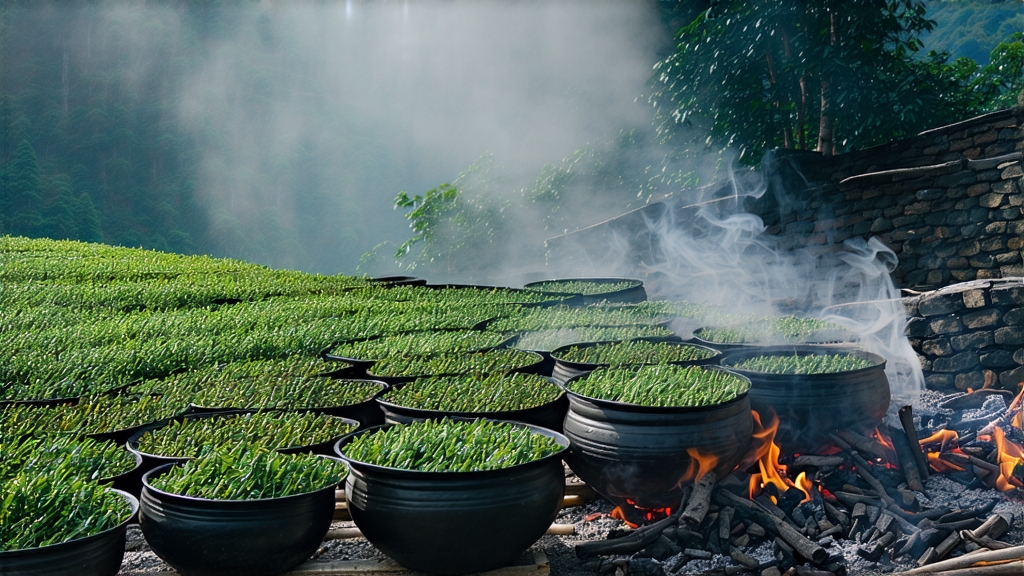
When European tea clippers first rounded the Cape of Good Hope in the mid-seventeenth century, the chests that fetched the highest prices at Amsterdam and London auctions bore one mysterious mark: “Bohea.” Inside were slender, pitch-black twists of leaf that, once steeped, exhaled a perfume unknown to the West—warm pine, dried longan, and a whisper of leather. That tea was Lapsang Souchong, the original black tea of the world and the progenitor of every keemun, ceylon, and assam that followed. Today, despite a crowded marketplace of fashionable cultivars, this sentinel from the Wuyi Mountains of Fujian still guards the gateway to China’s red-tea tradition, offering drinkers a liquid time-capsule of terroir, trade, and technique.
History: From Misty Gorges to Global Cup
Local legend fixes the birth of Lapsang Souchong in 1646, when Qing troops pressed through the Wuyi passes and bivouacked beside Tongmu village. To dry the fresh leaf before the soldiers requisitioned it, farmers rushed the withered leaves over open pine fires. The accidental smoke infusion proved irresistible to the Dutch factors who received it at Batavia, and within two decades “Bohea” became a European obsession. By 1700 the East India Company was chartering entire hulls for “souchong” (literally “sub-variety” or “small sort”), paying in silver because China wanted nothing else. The tea financed porcelain caravans, gilded the ceilings of English manor houses, and even inspired the porcelain pattern we now call “Blue Willow.” When the British finally planted stolen Chinese seeds in Assam and Ceylon, they were chasing the body and bite of this one Fujian original.
Micro-Terroir: Where Rock, River, and Resin Conspire
Authentic Lapsang can only be produced inside the 565 km² core zone of the Wuyi UNESCO Biosphere Reserve, an amphitheater of granite cliffs that trap humid monsoon clouds. Day-night temperature swings of 15 °C slow the growth of the indigenous Xiao Ye Zhong (“small-leaf species”) bushes that cling to weathered tuff soils. The same porosity that nurtures renowned cliff-grown oolong also imparts a mineral tension to souchong leaf, preventing the smoked character from becoming one-dimensional. Locals insist that the pine species matters equally: only Pinus massoniana, rich in resinous α- and β-pinene, delivers the sweet, cooling note that balances the ember-kissed leaf.
Leaf Hierarchy: Four Grades of Souchong
- Zheng Shan Xiao Zhong (Original Mountain Small Sort): picked before Qingming from 300–600 m elevations, smoked only with aged Masson pine, no foreign aroma.
- Wu Yuan Xiao Zhong: leaf from neighboring valleys, still within the reserve, but harvested after Guyu; gentler smoke, brighter cup.
- Yan Xiao Zhong (Cliff Small Sort): leaves plucked from inaccessible crevices at 800 m+; mineral depth rivals rock oolong, smoke subdued.
- Flavored Variants: modern exports scented with cinnamon, lychee, or even whisky barrel oak; these are considered “post-fermentation aromatized” and fall outside the China Protected Geographic Indication.
Craft: Turning Green into Night
The transformation begins at dusk. Pickers carry bamboo baskets of one-leaf-and-a-bud down narrow slate paths, arriving at the smoke-house by 8 p.m. Withering is conducted on bamboo screens suspended over dying embers—not yet smoky—so the leaf loses 30 % moisture while absorbing a preliminary resinous halo. At dawn the leaves are rolled 40 min under linen-wrapped wooden rollers, rupturing cells for oxidation. The critical “fermentation” follows: leaf piles 15 cm deep rest in pine-trunk troughs inside a room kept at 26 °C and 85 % humidity. Every 20 min the tea master fluffs the pile, listening for the rustle that signals enzymatic conversion from grassy to fruity. When the leaf turns chestnut-brown and exudes a raisin-sweet aroma, firing begins. Masson pine logs, aged three years to reduce sap, are stacked into a half-tunnel kiln. A wire mesh tray sits 1.2 m above the flames;